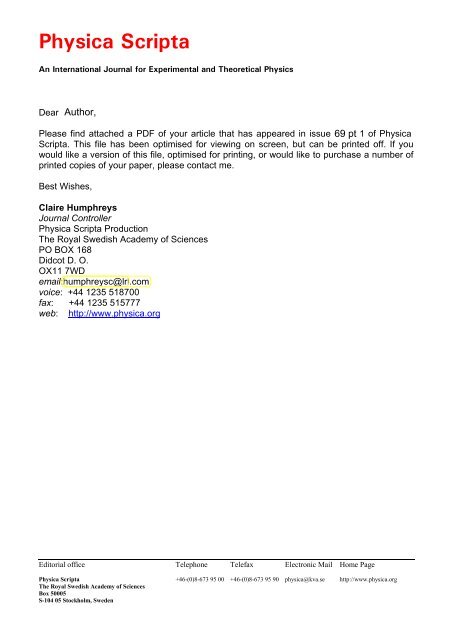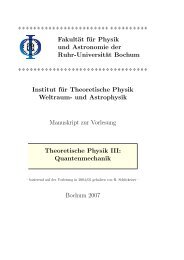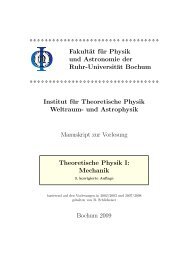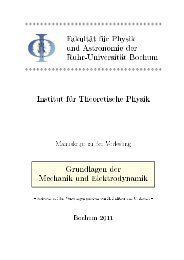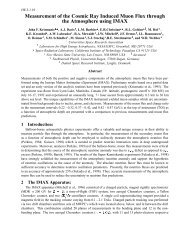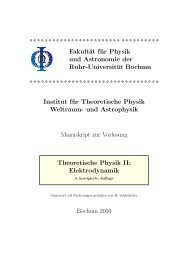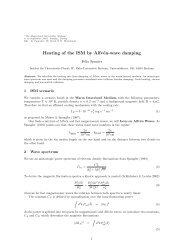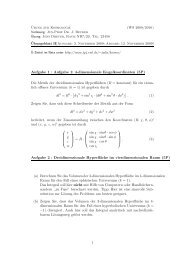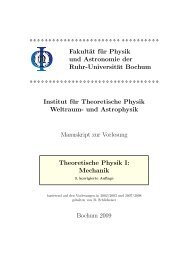PDF FILE - Theoretische Physik IV
PDF FILE - Theoretische Physik IV
PDF FILE - Theoretische Physik IV
Create successful ePaper yourself
Turn your PDF publications into a flip-book with our unique Google optimized e-Paper software.
Physica Scripta<br />
An International Journal for Experimental and Theoretical Physics<br />
Dear<br />
Please find attached a <strong>PDF</strong> of your article that has appeared in issue 1 of Physica<br />
Scripta. This file has been optimised for viewing on screen, but can be printed off. If you<br />
would like a version of this file, optimised for printing, or would like to purchase a number of<br />
printed copies of your paper, please contact me.<br />
Best Wishes,<br />
Claire Humphreys<br />
Journal Controller<br />
Physica Scripta Production<br />
The Royal Swedish Academy of Sciences<br />
PO BOX 168<br />
Didcot D. O.<br />
OX11 7WD<br />
email:humphreysc@lrl.com<br />
voice: +44 1235 518700<br />
fax: +44 1235 515777<br />
web: http://www.physica.org<br />
Editorial office Telephone Telefax Electronic Mail Home Page<br />
Physica Scripta +46-(0)8-673 95 00 +46-(0)8-673 95 90 physica@kva.se http://www.physica.org<br />
The Royal Swedish Academy of Sciences<br />
Box 50005<br />
S-104 05 Stockholm, Sweden
Physica Scripta. Vol. 69, 48–54, 2004<br />
Theory of Mach Cones in Magnetized Dusty Plasmas<br />
P. K. Shukla 1 , A. A. Mamun 1, and R. Bingham 2<br />
1 Institut fu¨ r <strong>Theoretische</strong> <strong>Physik</strong> <strong>IV</strong>, Fakultät fu¨ r <strong>Physik</strong> und Astronomie, Ruhr-Universität Bochum, D-44780 Bochum, Germany<br />
2 Rutherford Appleton Laboratory, Chilton, Didcot, Oxfordshire, OX11 0QX, England<br />
Received July 24, 2003; accepted August 7, 2003<br />
PACS Ref: 52.27. Lw, 52.35.Fp, 52.30Ex<br />
Abstract<br />
Theoretical models for Mach cones in magnetized dusty plasmas of Saturn’s<br />
rings are presented. Dispersion properties of different types of longitudinal and<br />
transverse waves (viz. dust–acoustic waves, fast and slow dust–magnetoacoustic<br />
waves) in magnetized dusty plasmas are presented. Numerical results are<br />
presented for V d =V p ð>1Þ; which determines the existence of Mach cones as<br />
well as their opening angles ½ ¼ sin 1 ðV p =V d ÞŠ; where V d is the dust boulder<br />
speed and V p ð¼ !=kÞ is the phase speed of short or long wavelength<br />
disturbances in magnetized dusty plasmas. It is found that short wavelength<br />
(in comparison with the ion gyroradius) modified dust–acoustic waves and long<br />
wavelength slow dust–magnetoacoustic waves (DMW) are viable candidates<br />
for the formation of Mach cones in the equatorial plane of Saturn’s rings. They<br />
should be observed by on board instruments of the CASSINI spacecraft that is<br />
supposed to enter Saturn’s orbit in July 2004.<br />
1. Introduction<br />
The structure and dynamics of Saturn’s rings continue to<br />
present surprises and challenges to celestial mechanics. The<br />
first surprise came in October 1980 when Voyager 1 sped<br />
pass Saturn and sent back lots of information and images,<br />
including pictures of mysterious dark spokes [1] sweeping<br />
around Saturn’s B-ring. The observations from Voyager 1<br />
revealed that the structure and dynamics of Saturn’s rings<br />
are mainly dominated by charged dust particles. It has also<br />
been proposed that the spokes might be charged dust and<br />
sculpted by the electrostatic forces, and that the electrostatic<br />
repulsion between charged dust particles and the<br />
boulders would raise trails of dust particles [2]. The<br />
CASSINI spacecraft, which will go into orbit around<br />
Saturn on 1 July 2004, promises to yield even more detailed<br />
information on Saturn’s rings. Since a direct probing of<br />
Saturn’s dense rings is not practically possible due to the<br />
danger of collisions, we must resort to remote sensing to<br />
investigate the physical conditions within such dense rings.<br />
We can do this by stellar occultation measurements, or<br />
through the observations of absorption of high-energy<br />
particles or radio-waves or of light scattering by dust<br />
particles at different angles. Recently, it has been proposed<br />
that observations of Mach cones in dusty plasmas [3–5]<br />
might play an interesting role as potential diagnosis<br />
method, since they can be directly viewed from outside<br />
Saturn’s dusty rings, and can be used for deducing<br />
information regarding the physical state of the ambient<br />
dusty plasma. Mach cones are cone or V-shaped disturbances<br />
formed by an object moving with a supersonic<br />
speed in a dispersive medium. The formation of Mach<br />
Permanent address: Department of Physics, Jahangirnagar University,<br />
Savar, Dhaka, Bangladesh.<br />
cones is well known in gases [6,7] and liquids [8]. These are<br />
produced, for example, by bullets and supersonic jet planes<br />
in gases. The disturbances produced by ships in water,<br />
which are formed behind ships in deep water and are<br />
known as the ‘‘Kelvin wedge’’, have shapes similar to<br />
Mach cones. Mach cones also occur in some crystals [9,10].<br />
Mach cones in rock is an interesting seismological<br />
phenomenon in which sound waves traveling in a liquidfilled<br />
bore hole move faster than the sound speed in the<br />
surrounding rock [11].<br />
Havnes et al. [3,4] theoretically predicted the existence of<br />
super dust–acoustic Mach cones associated with the dust–<br />
acoustic waves [12] of an unmagnetized dusty plasma,<br />
which are claimed to be relevant to Saturn’s rings. Dubin<br />
[13] developed a linear theory for the phonon wake<br />
produced by a charge moving relative to a crystalline<br />
lattice in an unmagnetized plasma containing dust grains<br />
which are strongly correlated. The theory predicts multiple<br />
Mach cones due to constructive interference of strongly<br />
dispersive compressional phonons. However, Dubin’s<br />
theory cannot be applied to Saturn’s magnetized plasmas<br />
in which dust grains are weakly correlated. In Saturn’s<br />
rings, we may have Mach cones associated with numerous<br />
dispersive plasma waves that are affected by the ambient<br />
magnetic field. For example, we may have an obliquely<br />
propagating intermediate frequency ð! cd ! ! ci ; k z v te ;<br />
where ! cd and ! ci are the dust and ion gyrofrequencies,<br />
respectively, k z is the component of the wave vector k along<br />
the external magnetic field ^zB 0 ; and v te is the electron<br />
thermal speed), long wavelength (in comparison with the<br />
electron Debye radius l De and the ion gyroradius s at the<br />
electron temperature) dust–acoustic waves [14] whose<br />
phase speed for k z l De ! pd =! pi is C De =ð1 þ k 2 ? 2 s Þ1=2 ;<br />
where C De ¼ l De ! pd ; s ¼ l De ! pi =! ci ;! pd ð! pi Þ is the dust<br />
(ion) plasma frequency, and k ? is the component of k<br />
across ^z: Here, the electrons rapidly thermalize along the<br />
magnetic field direction and follow a Boltzmann distribution,<br />
while the density distribution of magnetized ions<br />
(unmagnetized dust grains) are affected (unaffected) by the<br />
external magnetic field. Furthermore, in the opposite limit,<br />
viz. k z l De ! pd =! pi ; the dust grains can be considered<br />
immobile and the corresponding parallel (to ^z) phase speed<br />
of the dust ion–acoustic wave [15] is C I ¼<br />
l De ! pi =ð1 þ k 2 ? 2 s Þ1=2 ; indicating that the dust ion–acoustic<br />
waves are non-dispersive along the magnetic field direction.<br />
The high phase speed dust ion–acoustic waves would not<br />
participate in the Mach cone formation, as they propagate<br />
much faster than a dust boulder whose speed is given by<br />
Eq. (3). On the other hand, in the short wavelength (in<br />
Physica Scripta 69 # Physica Scripta 2004
Theory of Mach Cones in Magnetized Dusty Plasmas 49<br />
comparison with the ion gyroradius i ) dust acoustic fields,<br />
the ions follow a straight line orbit across ^z and establish a<br />
Boltzmann density distribution in the wave potential.<br />
Taking a Boltzmann electron density distribution and the<br />
density perturbation of inertial dust, one then obtains<br />
dust–acoustic waves whose phase speed is C D ¼ l D ! pd =<br />
ð1 þ k 2 l 2 D Þ1=2 ; where l D ¼ l De l Di =ðl 2 De þ l2 Di Þ1=2 and l Di is<br />
the ion Debye radius. As usual, for n i0 T e n e0 T i ; the dust–<br />
acoustic phase speed is [14] C d ¼ðZ 2 d n d0T i =n i0 m d Þ 1=2 ; where<br />
n i0 ; n e0 ; and n d0 are the equilibrium ion, electron, and dust<br />
particle number density, respectively, T e ðT i Þ is the electron<br />
(ion) temperature in units of the Boltzmann constant, Z d is<br />
the number of electrons residing onto the dust grain<br />
surface, and m d is the dust mass. For typical plasma<br />
parameters of Saturn’s rings [14–20], viz. B 0 ’ 0:2 G,<br />
T e ¼ 15 eV, T i ¼ 10 eV, n d0 ’ 10 cm 3 , n i0 ’ 10 4 cm 3 ,<br />
Z d ’ 10 3 , r d ’ 0:25 mm; where r d is the dust particle radius,<br />
one finds<br />
p<br />
that C 2 d =V 2 Ad ’ 5 10 5 ; where<br />
V Ad ¼ B 0 =<br />
ffiffiffiffiffiffiffiffiffiffiffiffiffiffiffiffiffi 4n d0 m d is the dust–Alfve´ n speed. It turns<br />
out that in Saturn’s rings, low-frequency (in comparison<br />
with the dust gyrofrequency), long wavelength (in comparison<br />
with the ion gyroradius) slow dispersive dust–<br />
magnetoacoustic waves [21] could also be relevant for the<br />
Mach cone formation. Fast dust magnetoacoustic waves<br />
[22,23] are unlikely to participate in the Mach cone<br />
formation.<br />
In this paper, we present possible theoretical models for<br />
Mach cones in magnetized dusty plasmas of Saturn’s rings.<br />
It is shown that short wavelength (in comparison with the<br />
ion gyroradius) modified dust–acoustic and long wavelength<br />
slow dust magnetoacoustic waves contribute to the<br />
formation of Mach cones in the equatorial plane of<br />
Saturn’s rings. We consider different classes of waves<br />
[viz. modified dust–acoustic waves (DAW), long wavelength<br />
modified fast magnetoacoustic waves (MW) and<br />
slow dust–magnetoacoustic waves (DMW)], and numerically<br />
analyze V d =V p in order to determine the condition<br />
ðV d =V p > 1Þ required for the existence of Mach cones as<br />
well as their opening angles ½ ¼ sin 1 ðV p =V d ÞŠ; where V d<br />
is the dust boulder speed and V p is the phase speed of short<br />
or long wavelength disturbances in a magnetized dusty<br />
plasma.<br />
The paper is organized as follows. An approximate<br />
expression for a dust boulder speed is presented in Section<br />
2. The formation of Mach cones due to intermediate<br />
frequency ð! cd ! ! ci Þ; short wavelength (in comparison<br />
with the ion gyroradius) modified DAW in a<br />
magnetized dusty plasma is considered in Section 3. The<br />
formation of Mach cones owing to low-frequency (in<br />
comparison with the ion and dust gyrofrequencies), long<br />
wavelength (in comparison with the ion gyroradius) MW<br />
and slow DMW are investigated in Sections 4 and 5,<br />
respectively. A brief discussion is given in Section 6.<br />
2. Dust dynamics<br />
We consider a negatively charged dust particle of mass m d<br />
and charge Z d e moving in a field which includes<br />
Keplerian gravity, corotating planetary magnetic field<br />
(taken to be aligned centered dipole) with concomitant<br />
induced electric field [16–20]. We first consider single<br />
particle dynamics and neglect the radiation pressure,<br />
plasma drag, planetary oblateness, charge fluctuations,<br />
and collective effects. The dynamics of such a negatively<br />
charged dust particle is governed by the combined<br />
gravitational, magnetic, and electric forces. The orbital<br />
angular velocity ! d of the negatively charged dust particle<br />
can, therefore, be expressed as [16,19]<br />
! d ¼ 1<br />
2r 3<br />
<br />
qffiffiffiffiffiffiffiffiffiffiffiffiffiffiffiffiffiffiffiffiffiffiffiffiffiffiffiffiffiffiffiffiffiffiffiffiffiffiffiffiffiffiffiffiffiffi<br />
! cd ! 2 cd þ 4r3 ð 2 k þ ! cd p Þ ; ð1Þ<br />
where r is the dust particle position normalized by the<br />
planet radius R p ;! cd ¼ Z d eB 0 =m d c and k ¼ðGM p =R 3 p Þ1=2<br />
are the dust gyro and Kepler frequencies, both evaluated at<br />
a point on the planetary equator; p is the planetary spin<br />
rate, M p is the planet mass, G is the universal gravitational<br />
constant, and c is the speed of light in vacuum. We note<br />
that in deriving Eq. (1) the planetary magnetic field B p is<br />
assumed to be dipolar with the dipole strength M ¼ B 0 R 3 p<br />
(where B 0 is the magnetic field strength on the planetary<br />
equator), which is appropriate for Saturn and Jupiter. The<br />
þð Þ sign in Eq. (1) represents prograde (retrograde)<br />
motion of the dust particle.<br />
A large boulder and a small dust particle will, therefore,<br />
move at difference speeds. The difference in speeds V d is<br />
given by<br />
V d ¼ rR p ð! d r 3=2 k Þ: ð2Þ<br />
To approximate V d ; let us consider a dust boulder in<br />
Saturn’s rings where [3,16,17,19,20] R p ¼ 60300 km;<br />
M p ¼ 5:688 10 26 kg; p ¼ 1:691 10 4 rad=s; r 2,<br />
B 0 ’ 0:2 G; Z d ’ 750; r d ’ 0:5 mm; so that k ¼ 4:16<br />
10 4 s 1 and ! cd ’ 3:67 10 5 s 1 : So for a particle in<br />
Saturn’s rings we can safely take the approximations<br />
! cd k ; p k ; and r 1; which allow us to<br />
approximate Eq. (2) as<br />
V d ’ R p! cd<br />
2r 2<br />
<br />
<br />
p<br />
r 3=2 1 : ð3Þ<br />
k<br />
Equation (3) represents an approximate expression for the<br />
speed of a dust boulder moving in Saturn’s equatorial<br />
plane under the combined effects of the gravitational,<br />
magnetic, and electric forces.<br />
3. Short wavelength DAW<br />
We first consider arbitrary wavelength DAW which may<br />
participate in the formation of Mach cones. To examine<br />
the possibility of the formation of dust–acoustic Mach<br />
cones, we consider a dusty magnetoplasma consisting of<br />
electrons, ions and negatively charged dust particles. Thus,<br />
at equilibrium we have n i0 ¼ n e0 þ Z d n d0 : When the<br />
wavelength of the DAW is comparable or shorter than<br />
the ion gyroradius i ð¼ v ti =! ci Þ; we cannot use the fluid<br />
theory to determine the ion density perturbation n i1 in the<br />
electrostatic DAW potential : Rather, we have to resort to<br />
the ion Vlasov equation to calculate the ion density<br />
perturbation. For ! ! ci and arbitrary b i ¼ k 2 ? 2 i values,<br />
# Physica Scripta 2004 Physica Scripta 69
50 P. K. Shukla, A. A. Mamun and R. Bingham<br />
we have n i1 ¼ ðk 2 =4eÞ i ; where the ion susceptibility<br />
involving two-dimensional ion motions is [24–27]<br />
i ’ 1 <br />
<br />
k 2 l 2 1 0ðb i Þþ2 1 ðb i Þ !2<br />
! 2 ; ð4Þ<br />
Di<br />
ci<br />
where l Di ¼ðT i =4n i0 e 2 Þ 1=2 ; 0;1 ¼ I 0;1 expð b i Þ; and I 0 ðI 1 Þ<br />
is the zero (first) order modified Bessel function.<br />
On the other hand, for ! k z v te ;! ce k z =k ? and<br />
b e ¼ k 2 ? v2 te =!2 ce 1; the electrons rapidly thermalize along<br />
^z and establish a Boltzmann distribution. The corresponding<br />
electron density perturbation is n e1 ¼ðk 2 =4eÞ e ;<br />
where the electron susceptibility is<br />
e ’ 1<br />
k 2 l 2 ; ð5Þ<br />
De<br />
where v te ¼ðT e =m e Þ 1=2 , ! ce ¼eB 0 =m e c, l De ¼ðT e =4n e0 e 2 Þ 1=2 ;<br />
and m e is the electron mass. For kv td ;! cd !; the dust<br />
grains can be considered cold and unmagnetized. The<br />
corresponding dust number density perturbation is<br />
n d1 ¼ðk 2 =4Z d eÞ d ; where the dust susceptibility is<br />
d ’<br />
!2 pd<br />
! 2 ; ð6Þ<br />
Fig. 2. V d =V p vs. k i curves in the case of the modified DAW in a<br />
where ! pd ¼ð4n d0 Z 2 d e2 =m d Þ 1=2 magnetized dusty plasma [Eq. (7)] for n d0 ¼ 10 cm<br />
:<br />
, B 0 ¼ 0:2 G,<br />
T i ¼ 10 eV, T e ¼ 10T i , n e0 ¼ 50 cm 3 , r ¼ 2;¼ 85 ; and for different<br />
Using Eqs. (4)–(6) the dispersion relation values of Z d and r d : The upper plot, where r d ¼ 0:5 mm; Z d ¼ 500 (solid<br />
1 þ e þ i þ d ¼ 0 can be expressed in the form [27] curve), Z d ¼ 750 (dotted curve) and Z d ¼ 1000 (dash curve), shows the<br />
1<br />
effect of Z d on V d =V p vs. k i curve. The lower plot, where<br />
1<br />
<br />
0 ðb i Þ<br />
! 2 ¼ k 2 C 2 D ; ð7Þ Z d ¼ 750; r d ¼ 0:5 mm (solid curve), r d ¼ 0:6 mm (dotted curve), and<br />
r d ¼ 0:7 mm (dashed curve), shows the effect of r d on V d =V p vs. k i curve.<br />
ci<br />
where ¼ 1 þ k 2 l 2 Di þ n e0T i =n i0 T e : In the short wavelength<br />
limit ðb i 1Þ: Equation (7) reduces to ! ¼ kC D ; which<br />
coincides with the dispersion relation of Rao, Shukla and<br />
Yu’s DAW. Thus, in the short wavelength dust acoustic<br />
wave potential, unmagnetized ions, which have a Boltzmann<br />
density distribution, follow a straight line orbit<br />
across ^z: However, as shown in Figs. 1 and 2, the ion<br />
dynamics is affected by the magnetic field when the<br />
modified DAW have wavelengths satisfying k i 0:6:<br />
As we have physically explained in the introduction,<br />
Mach cones can be formed by any perturbation (e.g., short<br />
wavelength modified DAW and long wavelength slow<br />
DMW in our case) if the perturbing object (viz. a dust<br />
boulder in our case) speed V d is larger than the wave phase<br />
speed V p ¼ !=k; i.e., V d =V p > 1: If this condition is<br />
satisfied, the Mach cone opening angle is given by<br />
<br />
¼ sin 1 V p<br />
;<br />
V d<br />
ð8Þ<br />
Fig. 1. V d =V p vs. k i curves in the case of modified DAW in a magnetized<br />
dusty plasma [Eq. (7)] for n d0 ¼ 10 cm 3 , Z d ¼ 750, T e ¼ 10T i ,<br />
n e0 ¼ 50 cm 3 , r ¼ 2; r d ¼ 0:5 mm;¼ 85 ; and for different values of T i<br />
and B 0 : The upper plot, where B 0 ¼ 0:2 G; T i ¼ 10 eV (solid curve),<br />
T i ¼ 20 eV (dotted curve), and T i ¼ 30 eV (dash curve), shows the effect of<br />
T i on V d =V p vs. k i curve. The lower plot, where T i ¼ 10 eV; B 0 ¼ 0:05 G<br />
(solid curve), B 0 ¼ 0:1 G (dotted curve), and B 0 ¼ 0:2 G (dashed curve),<br />
shows the effect of B 0 on V d =V p vs. k i curve.<br />
where V d is given by Eq. (3) and V p ¼ !=k will depend on<br />
the perturbation (waves) we consider. For the modified<br />
DAW in a magnetized dusty plasma, V p will be determined<br />
from Eq. (7). However, for short wavelength ðb i 1Þ<br />
DAW V p can be simplified as V p C D :<br />
We have numerically analyzed the dust boulder speed V d<br />
given by Eq. (3) and the wave phase speed V p ¼ !=k<br />
determined from Eq. (7). The numerical results are displayed<br />
in Figs. 1 and 2. The lower plot of Fig. 1 shows that the<br />
condition for the Mach cone formation ðV d =V p > 1Þ is not<br />
satisfied for B 0 ¼ 0:05 G: However, if B 0 is further increased,<br />
dust–acoustic Mach cones are found to be formed. This<br />
Physica Scripta 69 # Physica Scripta 2004
Theory of Mach Cones in Magnetized Dusty Plasmas 51<br />
means that the increase in the ambient magnetic field, which<br />
increases the dust boulder speed (V d is found to be 10.3, 20.6,<br />
and 41.2 m/s for planetary magnetic fields of 0.05, 0.1, and<br />
0.2 G, respectively) is in the favor of the formation of<br />
modified dust–acoustic Mach cones. The upper plot of Fig. 1<br />
shows that as we increase the ion temperature, V d =V p<br />
decreases. This implies that higher ion temperature is not in<br />
favor of the formation of the dust–acoustic Mach cones. The<br />
lower plot of Fig. 2 shows that as we increase the dust grain<br />
radius, V d =V p decreases. This means that larger dust<br />
particles are not in favor of the formation of the dust–<br />
acoustic Mach cones [3]. The upper plot of Fig. 2 shows that<br />
as we increase the magnitude of the dust charge, V d =V p<br />
increases. This means that more negatively charged dust<br />
particles are in favor of the formation of short wavelength<br />
dust–acoustic Mach cones. From Figs. 1 and 2 it is also<br />
obvious how the Mach cone opening angle<br />
¼ sin 1 ðV p =V d Þ varies with k; B 0 ; T i ; r d ; and Z d : For<br />
Saturn’s plasma parameters, we have estimated the Mach<br />
cone opening angle associated with the modified DAW of<br />
wavelength 30 m propagating at an angle ¼ 85 against<br />
the magnetic field direction. These are 38 and 17 for<br />
B 0 ¼ 0:1 G and B 0 ¼ 0:2 G; respectively.<br />
direction. Thus, the x- and y-components of the electron<br />
and ion fluid velocities are<br />
v ex ¼ c B 0<br />
E y ;<br />
v ey ¼<br />
v ix ¼ c B 0<br />
E y ;<br />
cT e<br />
eB 0 n e0<br />
@ x n e1 ;<br />
ð11Þ<br />
ð12Þ<br />
ð13Þ<br />
v iy ¼<br />
cT i<br />
@ x n i1 þ<br />
c @ t E y ;<br />
ð14Þ<br />
eB 0 n i0 B 0 ! ci<br />
where @ x ¼ @=@x: Using v ex and v ix in the electron and ion<br />
continuity equations we have<br />
@ t n e1 ¼<br />
n e0c<br />
@ x E y ;<br />
B 0<br />
ð15Þ<br />
@ t n i ¼<br />
n i0c<br />
@ x E y :<br />
B 0<br />
ð16Þ<br />
Using Eqs. (12) and (14)–(16) in Faraday’s and Ampere’s<br />
laws<br />
rE ¼ 1 c @ tB; ð17Þ<br />
4. Long wavelength fast MW<br />
We are now interested in examining whether lowfrequency,<br />
long wavelength modified fast MW participate<br />
in the formation of Mach cones in the magnetized<br />
(electron–ion–dust) dusty plasmas of Saturn’s rings. In<br />
his classic paper, Rao [23] predicted an elliptically<br />
polarized modified magnetoacoustic wave in an electron–<br />
ion plasma with immobile dust grains. The dispersion<br />
relation for Rao’s modified magnetoacoustic waves propagating<br />
perpendicular to the ambient magnetic field direction<br />
is given by !<br />
p<br />
2 ¼ðZ d n d0 =n e0 Þ 2 ! 2 ci þ k2 ðV 2 A þ V 2 S Þ;<br />
where V A ¼ðn i0 =n e0 ÞB 0 = ffiffiffiffiffiffiffiffiffiffiffiffiffiffiffi 4n i0 m i , V S ¼½ðn i0 e T e þ n e0 i T i Þ=<br />
m i n e0 Š 1=2 ; and e ð i Þ is the adiabatic index for the electron<br />
(ion) fluid. Rao’s mode, which has a cut-off frequency<br />
ðZ d n d0 =n i0 Þ! ci is strongly dispersive. Properties of lowfrequency<br />
dust magnetosonic waves in dusty plasmas of<br />
planetary rings have also been examined by Lee and<br />
Havnes [28], and Verheest and Hellberg [29].<br />
In the following, we examine the dispersion properties of<br />
linearly polarized fast magnetoacoustic waves including the<br />
dust particle dynamics. In the presence of low-frequency<br />
ð! ! ci Þ long wavelength ðk 2 2 i 1Þ electromagnetic<br />
fields, we can express the perpendicular components of<br />
the electron and ion fluid velocities (u e? and u i? )as<br />
u e? ’ c <br />
<br />
T e<br />
E ? ^z ^z rn e1 ; ð9Þ<br />
B 0<br />
en e0<br />
u i? ’ c <br />
E ? ^z þ T i<br />
^z rn i1 þ 1 <br />
@ t E ? ; ð10Þ<br />
B 0<br />
en i0 ! ci<br />
where n e1 ðn i1 Þ is a perturbed part of the electron (ion)<br />
number density, E ? is the perpendicular component of the<br />
electric field E; and @ t ¼ @=@t: We assume that the<br />
electromagnetic waves under consideration are linearly<br />
polarized (viz. E ¼ ^yE y Þ and are propagating along the x-<br />
rB ¼ 4e<br />
c ðn i0u i n e0 u e Z d n d0 u d Þ; ð18Þ<br />
we obtain<br />
<br />
@ 2 t VAi 2 þ C 2 ! 2<br />
s @<br />
2 pi<br />
x<br />
! 2 E y ¼ 4Z d n d0 e@ t u dy ; ð19Þ<br />
ci<br />
p<br />
where V Ai ¼ B 0 =<br />
ffiffiffiffiffiffiffiffiffiffiffiffiffiffiffi 4n i0 m i ; C s ¼ðT i þ T e n e0 =n i0 Þ=m i ; and<br />
u dy is the y-component of the dust fluid velocity u d :<br />
4.1. Unmagnetized dust<br />
We first consider the unmagnetized dust limit which is valid<br />
when the dust gyrofrequency is much smaller than the<br />
frequency of the waves we have considered herein. In the<br />
presence of a linearly polarized electric field (viz. E ¼ ^yE y ),<br />
the motion of a cold dust fluid is confined along the y-<br />
direction, and is given by<br />
@ t v dy ¼<br />
Z de<br />
E y :<br />
ð20Þ<br />
m d<br />
Now using Eqs. (19) and (20) we obtain<br />
<br />
@ 2 t VAi 2 þ C 2 <br />
s @<br />
2<br />
x þ 2 <br />
d Ey ¼ 0; ð21Þ<br />
where d ¼ ! pd ! ci =! pi : Now, assuming E y / exp½ i!t<br />
þik x xÞŠ; we obtain from (21)<br />
! 2 ¼ k 2 x V 2 Ai þ C 2 s<br />
<br />
þ <br />
2<br />
d : ð22Þ<br />
Equation (22) represents the dispersion relation for long<br />
wavelength, modified fast MW in a dusty magnetoplasma.<br />
Equation (22) admits a cutoff frequency ! ¼ d : On<br />
the other hand, for 2 d k2 x ðV Ai 2 þ C 2 s Þ we obtain<br />
! ’ d þ k 2 x ðV Ai 2 þ C 2 s Þ=2 d: Moreover, when the dust<br />
dynamics is ignored [viz. we set d ¼ 0 in Eq. (22)], we<br />
# Physica Scripta 2004 Physica Scripta 69
52 P. K. Shukla, A. A. Mamun and R. Bingham<br />
obtain the usual fast MW in which the sum of the magnetic<br />
and plasma thermal pressures provide the restoring force<br />
and the ion mass provides the inertia. For typical plasma<br />
parameters corresponding to Saturn’s rings [14,16–19], we<br />
have C 2 s =V Ai 2 ’ 10 4 : We have numerically analyzed the<br />
dust boulder speed V d ; given by Eq. (3), and the wave<br />
phase speed V p ¼ !=k x obtained from Eq. (22). We find<br />
that V d =V p is always much less than one. Hence, long<br />
wavelength fast MW, given by (22), would not participate<br />
in the formation of Mach cones in Saturn’s rings.<br />
4.2. Magnetized dust<br />
To examine the possibility of Mach cone formation due to<br />
long-wavelength ðk i 1Þ; low-frequency ð! ! ci Þ MW,<br />
we now relax the restriction ! cd !; and consider<br />
magnetized dust. In the presence of linearly polarized<br />
MW, the x- and y- components of the dust fluid velocity u d<br />
are given by<br />
5. Long wavelength slow DMW<br />
We are now interested in examining the possibility for<br />
formation of Mach cones involving obliquely propagating<br />
long wavelength ðk 2 x 2 i 1Þ slow DMW in dusty magnetoplasmas<br />
of Saturn’s rings. Here, for simplicity, we<br />
consider two-component magnetized dusty plasma composed<br />
of negatively charged dust grains and positively<br />
charged ions. We assume that the electron number density<br />
is highly depleted due to the attachment of almost all the<br />
plasma electrons onto the surface of highly charged and<br />
massive dust grains. This model is quite appropriate for<br />
Saturn’s rings (e.g., Saturn’s F-ring [14–18]). We consider a<br />
small amplitude perturbation in such a dust–ion plasma,<br />
which may be described by two linearized coupled<br />
equations [21]<br />
@ 2 u d<br />
@t 2 þ V 2 <br />
Ad<br />
r @2 B<br />
! ci @t 2 V 2 Ad r @B <br />
@t<br />
ð@ 2 t þ !2 cd Þv dx ¼ c B 0<br />
! 2 cd E y;<br />
ð23Þ<br />
^z<br />
C 2 d rru ð dÞ ¼ 0; ð29Þ<br />
ð@ 2 t þ !2 cd Þv dy ¼ c B 0<br />
! cd @ t E y : ð24Þ<br />
@B<br />
@t þ ^z 1<br />
ðru d Þ ð^z rÞu d r @u d<br />
! cd @t ¼ 0;<br />
ð30Þ<br />
By using Eqs. (19) and (24), and assuming E y /<br />
exp½ i!t þ ik x xÞŠ; we obtain<br />
! 4 ! 2 ! 2 cd þ 2 d þ k2 x V 2 m<br />
þ !<br />
2<br />
cd k 2 x V 2 m ¼ 0; ð25Þ<br />
where V 2 m ¼ V Ai 2 þ C 2 s : Equation (25) is the dispersion<br />
relation for long wavelength low-frequency coupled dust–<br />
cyclotron and modified fast MW in a magnetized dusty<br />
plasma. The non-dispersive dust–cyclotron waves are<br />
uninteresting for Mach cones. So, in the following, we<br />
consider two limiting cases.<br />
(i) ! 2 ! 2 cd<br />
: This case reduces Eq. (25) to a simple<br />
form<br />
! 2 ’ k 2 x V 2 m þ 2 d ; ð26Þ<br />
which coincides with Eq. (22).<br />
(ii) ! 2 ! 2 cd<br />
: This case reduces Eq. (25) to<br />
! 2 ’ k2 x V 2 m<br />
1 þ 2 ; ð27Þ<br />
d =!2 cd<br />
which represents the dispersion relation for fast MW in<br />
multi-component (electron–ion–dust) magnetized dusty<br />
plasmas. When 2 d =!2 cd 1 and n e0=n i0 1 (which are<br />
valid for the plasma parameters of Saturn’ rings), we<br />
obtain from Eq. (27)<br />
! 2 ’ k 2 x V 2 Ad þ C 2 d<br />
; ð28Þ<br />
which is the simplest form of the dispersion relation for long<br />
wavelength fast DMW in which the sum of magnetic and ion<br />
thermal pressures provide the restoring force and the dust<br />
mass provides the inertia. Using Saturn’s plasma parameters,<br />
we have numerically analyzed the dust boulder speed<br />
V d ; given by Eq. (3), and the wave phase speed V p ¼ !=k x ;<br />
given by Eq. (25). It is found that V d =V p is always less than<br />
one (i.e., V d =V p 1). Hence, long wavelength fast DMW<br />
defined by Eq. (25) would not participate in the formation of<br />
Mach cones in Saturn’s rings.<br />
where B is the wave magnetic field normalized to B 0 :<br />
We now assume that the perturbation mode propagates in<br />
the xz plane, i.e., B and u d are proportional to<br />
exp½ i!t þ iðk x x þ k z zÞŠ: Therefore, using Eqs. (29) and<br />
(30) we obtain<br />
0<br />
10<br />
1<br />
D xx D xy D xz B x<br />
B D yx D yy D yz CB<br />
B y C<br />
@<br />
A@<br />
A ¼ 0;<br />
ð31Þ<br />
D zx D zy D zz<br />
where<br />
B z<br />
D xx;zz ¼ 1 þ k 2 k 2<br />
z;x l2 i !<br />
z;x V 2 Ad ð!2 k 2 z C 2 d Þ<br />
!ð! 2 k 2 C 2 d Þ ;<br />
<br />
D xy ¼ D yx ¼ ik 2 z V 2 Ad<br />
1 1<br />
! cd ! ci<br />
<br />
;<br />
D xz ¼ D zx ¼ !k z k x l 2 i þ k zk x V 2 Ad ð!2 k 2 z C 2 d Þ<br />
!ð! 2 k 2 C 2 d Þ ;<br />
D yy ¼ 1 þ k 2 l 2 <br />
i !<br />
k 2 z V 2 Ad<br />
! ;<br />
<br />
D yz ¼ D zy ¼ ik z k x V 2 Ad<br />
1 1<br />
! cd ! ci<br />
<br />
:<br />
9<br />
>=<br />
>;<br />
ð32Þ<br />
Here l i ¼ c=! pi is the ion skin depth. We note that the<br />
origin of the dispersive effect involving the kl i term is<br />
attributed to the ion inertial effect, which breaks the<br />
frozen-in-field condition in a magnetized dust–ion plasma.<br />
We are interested in ultra low-frequency ð! ! cd Þ long<br />
wavelength ðk i 1Þ obliquely propagating DMW.<br />
Within such frequency and wavelength regimes, Eq. (31)<br />
reduces to three types of obliquely propagating dust–<br />
magnetohydrodynamic waves. These are [21]<br />
!<br />
k ¼ V Ad cos <br />
q ffiffiffiffiffiffiffiffiffiffiffiffiffiffiffiffiffi ; ð33Þ<br />
1 þ k 2 l 2 i<br />
Physica Scripta 69 # Physica Scripta 2004
Theory of Mach Cones in Magnetized Dusty Plasmas 53<br />
and<br />
"<br />
!<br />
k ¼ 1 V 2 Ad<br />
pffiffiffi<br />
2 1 þ k 2 l 2 þ C 2 d<br />
i<br />
vffiffiffiffiffiffiffiffiffiffiffiffiffiffiffiffiffiffiffiffiffiffiffiffiffiffiffiffiffiffiffiffiffiffiffiffiffiffiffiffiffiffiffiffiffiffiffiffiffiffiffiffiffiffiffiffiffiffiffiffiffiffiffiffiffiffiffiffiffiffiffiffiffi<br />
! 3<br />
2<br />
u V 2 Ad<br />
<br />
1 þ k 2 l 2 þ C 2 4V 2 Ad C2 d cos2 <br />
t<br />
5<br />
d<br />
i<br />
1 þ k 2 l 2 i<br />
1=2<br />
; ð34Þ<br />
where is the angle between the directions of the ambient<br />
magnetic field and the wave propagation.<br />
Equation (33) represents the dispersion relation for the<br />
shear dust–Alfvén waves modified by the effect of the ionskin<br />
p<br />
depth which decreases their phase speed by the factor<br />
1 þ k2 l 2 i : On the other hand, Eq. (34) with þð Þ sign<br />
represents the dispersion relation for the fast (slow) DMW<br />
modified by the effect of the ion-skin depth and obliqueness.<br />
For typical plasma parameters of Saturn rings [14,<br />
16–19], we find that C 2 d =V 2 Ad ’ 3:7 10 5 : It is then likely<br />
that Mach cones in Saturn’s rings may also involve long<br />
wavelength, slow DMW with kl i ’ 1; rather than long<br />
wavelength ðb i 1Þ ultra low-frequency ð! ! cd Þ DAW.<br />
We have numerically analyzed V d =V p for typical plasma<br />
parameters given in the figure caption. The numerical<br />
results are depicted in Figs. 3 and 4. Figure 3 shows that<br />
Mach cones are formed by shear dust–Alfve´ n waves of<br />
wavelength 7 km or less (cf. lower plot), and by slow<br />
DMW without the upper bound on the wavelength (cf.<br />
upper plot). We have also found that the upper bound on<br />
the wavelength of both the shear dust–Alfvén and slow<br />
DMW by which Mach cones are formed increases as we<br />
increase their propagation angle (cf. lower and upper<br />
plots of Fig. 3). We observe here that for the plasma<br />
parameters of Saturn’s rings, Mach cones are not formed<br />
by fast DMW.<br />
Fig. 4. Wavelength regimes of slow DMW for which Mach cones are<br />
formed in Saturn’s rings (n d ¼ 10 cm 3 ; Z d ¼ 750; r ¼ 2; r d ¼ 0:5 mm; and<br />
¼ 85 ).The upper plot, where T i ¼ 10 eV; B 0 ¼ 0:05 G (solid curve),<br />
B 0 ¼ 0:1 G (dotted curve) and B 0 ¼ 0:2 G (dash curve), shows the effect of<br />
B 0 on V d =V p vs. l curve. The lower plot, where B 0 ¼ 0:2 G; T i ¼ 10 eV<br />
(solid curve), T i ¼ 20 eV (dotted curve), and T i ¼ 30 eV (dashed curve),<br />
shows the effect of T i on V d =V p vs. l curve.<br />
We have also examined the effects of the ion temperature<br />
T i and the ambient magnetic field B 0 on the formation of<br />
Mach cones associated with the shear dust–Alfve´ n and<br />
slow DMW. We find that the ion temperature T i and the<br />
ambient magnetic field ðB 0 Þ have an insignificant effect on<br />
the formation of Mach cones and their opening angles<br />
associated with the shear dust–Alfve´ n waves. However,<br />
these do have significant effects on the associated slow<br />
DMW. These are depicted in Fig. 4. It is seen that as we<br />
increase (decrease) B 0 ðT i Þ the maximum wavelength for<br />
which Mach cones are formed increases, but the opening<br />
angle decreases.<br />
From Figs. 3 and 4 it is also obvious how the Mach cone<br />
opening angle ¼ sin 1 ðV p =V d Þ varies with l;;B 0 ; and<br />
T i : For Saturn’s ring parameters, we have estimated the<br />
Mach cone opening angle associated with the shear dust–<br />
Alfve´ n and slow DMW of wavelengths of 5 km, propagating<br />
with an angle ¼ 85 : These are 32 and 4 ;<br />
respectively.<br />
Fig. 3. Wavelength regimes of slow DMW (upper plot) and of shear dust–<br />
Alfvén (lower plot) propagating with different angle for which Mach<br />
cones are formed in Saturn’s rings (B 0 ¼ 0:2 G, T i ¼ 10 eV, n d ¼ 10 cm 3 ,<br />
Z d ¼ 750, r ¼ 2, r d ¼ 0:5 mm). The solid, dotted and dashed curves are for<br />
¼ 85 ;¼ 87 ; and ¼ 89 in both the plots.<br />
6. Discussion and conclusions<br />
We have presented theoretical models for Mach cones in<br />
magnetized dusty plasmas of Saturn’s rings. We have<br />
considered different classes of waves (viz. short wavelength<br />
modified DAW, long wavelength modified fast MW, long<br />
wavelength shear Alfve´ n waves and slow DMW), and have<br />
numerically analyzed V d =V p which is decisive for the<br />
condition ðV d =V p > 1Þ required for the formation of Mach<br />
cones, as well as their opening angles ½ ¼ sin 1 ðV p =V d ÞŠ:<br />
It is found that intermediate frequency ð! cd ! ! ci Þ;<br />
short wavelength (in comparison with the ion gyroradius)<br />
modified DAW and long wavelength ðk 2 ? 2 i 1Þ; ultra<br />
low-frequency ð! ! cd Þ slow DMW are viable candidates<br />
# Physica Scripta 2004 Physica Scripta 69
54 P. K. Shukla, A. A. Mamun and R. Bingham<br />
for the formation of Mach cones in the equatorial region of<br />
Saturn’s rings. Mach cones may arise owing to the<br />
constructive interference of modified DAW (in the short<br />
wavelength limit) or slow DMW (in the long wavelength<br />
limit) in dusty magnetoplasmas of Saturn’s dense rings. We<br />
expect that the NASA/ESA space probe CASSINI can<br />
make direct observations of Mach cones involving the<br />
modified dust acoustic and slow dust–magnetoacoustic<br />
modes, which are reported in this paper. The opening<br />
angles of the corresponding Mach cones,which we have<br />
estimated herein, can be used for obtaining the dust mass<br />
density, dust charge, dust composition, and the optical<br />
depth of Saturn’s dense rings. Although the present<br />
investigation provides the parameter regimes for the<br />
existence of short wavelength modified dust–acoustic or<br />
long wavelength slow dust–magnetoacoustic Mach cones,<br />
the fine structures of dust–acoustic and dust magnetoacoustic<br />
wakes behind a dust boulder can be obtained by<br />
solving numerically the dust–acoustic and dust–magnetoacoustic<br />
wave equations with appropriate sources. This<br />
investigation can be carried out on the lines of Brattli et al.<br />
[5].<br />
We mention that although the formation of Mach cones<br />
in a magnetized dusty plasma of Saturn rings is attributed<br />
to constructive interference between linear dispersive DAW<br />
or DMW, nonlinear and dissipative effects can appear<br />
when the wave amplitudes are large and dust charge<br />
fluctuations [30] are taken into consideration. A delicate<br />
balance between nonlinearity and dissipation can produce<br />
dust–ion–acoustic shock waves [31,32] in an unmagnetized<br />
dusty plasma. However, a detailed investigation of the dust<br />
grain charging in a magnetized dusty plasma containing<br />
large amplitude modified dust–acoustic and slow DMW is<br />
quite involved, and is beyond the scope of the present<br />
paper. We anticipate that dust charge perturbation effects<br />
might be insignificant since the dust grain charging time<br />
[33] is typically much shorter than the time scale on which<br />
the modified dust–acoustic and slow dust magnetoacoustic<br />
perturbations develop.<br />
Acknowledgements<br />
The authors thank Professors Ove Havnes, Miha´ ly Hora´ nyi, and Asoka<br />
Mendis for invaluable discussions. This work was partially supported by the<br />
Deutsche Forschungsgemeinschaft (Bonn, Germany) through the Sonderforschungsbereich<br />
591 ‘‘Gleichgewichtferners Plasmen’’, as well as by the<br />
European Commission (Brussels, Belgium) through Contract Nos. HPRN-CT-<br />
2000-00140 and HPRN-CT-2001-00314. A.A.M. gratefully acknowledges the<br />
financial support of the Alexander von Humboldt-Stiftung (Bonn, Germany).<br />
References<br />
1. Smith, B. A. et al., Science 212, 163 (1981).<br />
2. Hill, J. R. and Mendis, D. A., Moon Planets 24, 431 (1981).<br />
3. Havnes, O. et al., J. Geophys. Res. 100, 1731 (1995).<br />
4. Havnes, O. et al., J. Vac. Sci. Technol. A 14, 525 (1996).<br />
5. Brattli, A., Havnes, O. and Melandsø, F., Phys. Plasmas 9, 985 (2002).<br />
6. Liepman, H. W. and Roshko, A., ‘‘Elements of Gas Dynamics,’’<br />
(Wiley, New York, 1957).<br />
7. Bond, J., Watson, K. and Welch, J., ‘‘Atomic Theory of Gas<br />
Dynamics,’’ (Addison-Wesley, Reading, 1965).<br />
8. Crapper, G., ‘‘Introduction to Water Waves,’’ (Chichester, Harwood,<br />
1984).<br />
9. Gumbsch, P. and Gao, H., Science 283, 965 (1999).<br />
10. Samsonov, D. et al., Phys. Rev. Lett. 83, 3649 (1999).<br />
11. Cheng, N., Zhu, Z., Cheng, C. and Toksöz, M., Geophys. Prospect.<br />
42, 303 (1994).<br />
12. Rao, N. N., Shukla, P. K. and Yu, M. Y., Planet. Space Sci. 38, 543<br />
(1990).<br />
13. Dubin, D. E., Phys. Plasmas 7, 3895 (2000).<br />
14. Shukla, P. K. and Mamun, A. A., ‘‘Introduction to Dusty Plasma<br />
Physics,’’ (Institute of Physics Publ. Ltd., Bristol, 2002).<br />
15. Shukla, P. K. and Silin, V. P., Physica Scripta 45, 508 (1992).<br />
16. Mendis, D. A., Houpis, H. L. F. and Hill, J. R., J. Geophys. Res. 87,<br />
3449 (1982).<br />
17. Mendis, D. A. and Rosenberg, M., Annu. Rev. Astron. Astrophys. 32,<br />
419 (1994).<br />
18. Mendis, D. A., Plasma Sources Sci. Technol. 11, A219 (2002).<br />
19. Howard, J. E., Horányi, M. and Stewart, G. R., Phys. Rev. Lett. 83,<br />
3993 (1999).<br />
20. Horányi, M., Phys. Plasmas 7, 3847 (2000).<br />
21. Mamun, A. A., Shukla, P. K. and Bingham, R., Pis’ma v ZhETF 77,<br />
110 (2003) [JETP Lett. 77, 541 (2003)].<br />
22. Rao, N. N., Physica Scripta 48, 363 (1993).<br />
23. Rao, N. N., J. Plasma Phys. 53, 317 (1995).<br />
24. Brambilla, M., ‘‘Kinetic Theory of Plasma Waves: Homogeneous<br />
Plasmas,’’ (Clarendon Press, Oxford, 1998).<br />
25. Shukla, P. K. and Stenflo, L., J. Plasma Phys. 64, 125 (2000).<br />
26. Shukla, P. K., Mamun, A. A. and Bingham, R., Pis’ma v ZhETF 78,<br />
110 (2003).<br />
27. Shukla, P. K. and Mamun, A. A., Phys. Lett. A 315, 451 (2003).<br />
28. Lee, F. and Havnes, O., Planet. Space Sci. 48, 117 (2000).<br />
29. Verheest, F. and Hellberg, M. A., IEEE Trans. Plasma Sci. 29, 283<br />
(2001).<br />
30. Varma, R. K., Shukla, P. K. and Krishan, V., Phys. Rev. E 47, 3612<br />
(1993).<br />
31. Popel, S. I., Golub’, A. P. and Losea, T. V., JETP Lett. 74, 396 (2001).<br />
32. Mamun, A. A. and Shukla, P. K., IEEE Trans. Plasma Sci. 30, 720<br />
(2002).<br />
33. Verheest, F., ‘‘Waves in Dusty Space Plasmas,’’ (Kluwer Academic<br />
Publishing Dordrecht, 2000).<br />
Physica Scripta 69 # Physica Scripta 2004


